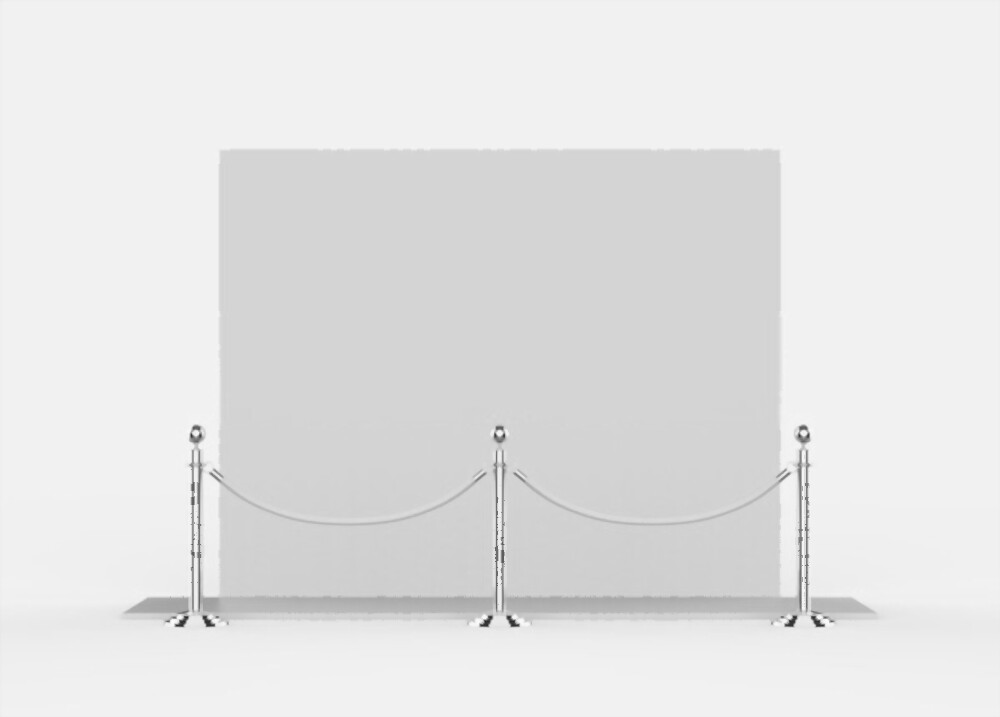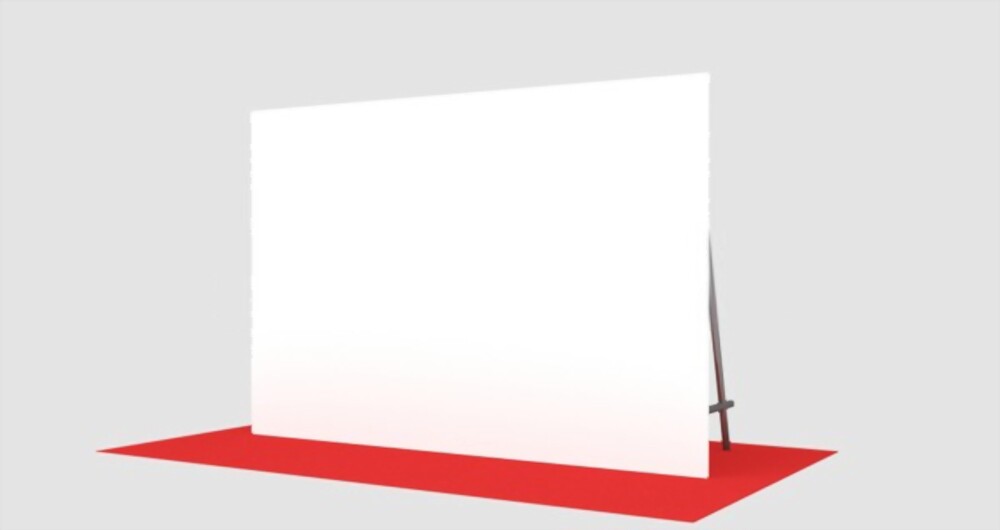When it comes to promoting a brand or event, having an eye-catching backdrop can make a significant impact. Step and repeat banners are a popular choice for creating a visually appealing background that showcases logos and sponsors.
Step-and-repeat backdrops are readily available in the market in two standard sizes, namely 5 × 8 feet and 8 × 8 feet. However, the size of the backdrop may vary based on the expected number of individuals who will stand in front of it. If you need a larger size, there is an 8 × 20 feet option that can accommodate up to 10 people at once, making it the largest size commonly available in the market.
However, to achieve the desired effect, it’s crucial to understand the standard sizes of step and repeat banners. In this article, I will delve into the topic and explore the various aspects related to step and repeat sizes.
What are the Standard Sizes of Step and Repeat?
8 feet by 8 feet (96 inches by 96 inches or approximately 243.84 cm by 243.84 cm): This is a popular size for step and repeat banners. It provides a good amount of space for logos or patterns and is large enough to accommodate multiple people for photos.
8 feet by 10 feet (96 inches by 120 inches or approximately 243.84 cm by 304.8 cm): This size offers a slightly wider backdrop than the 8×8 option, providing more room for larger groups or additional branding elements.
10 feet by 10 feet (120 inches by 120 inches or approximately 304.8 cm by 304.8 cm): This size is commonly used for step and repeat banners at larger events. It offers a square backdrop that can accommodate more people or provide extra space for logos and designs.
8 feet by 12 feet (96 inches by 144 inches or approximately 243.84 cm by 365.76 cm): This size is often chosen when a wider backdrop is required, such as for group photos or when multiple logos need to be displayed.
| Dimension (height *width in feet) | Description |
| 8 × 10 | Up to 5 people |
| 8 × 12 | Up to 6 people |
| 5 × 8 | Up to 2 people |
| 8 × 8 | Up to 4 people |
| 8 × 20 | Up to 10 people |
| 8 × 15 | Up to 8 people |
Related: What Is The Standard Backdrop Size? Complete Guide
Step and Repeat Examples
To gain inspiration and ideas for your step and repeat banner, here are a few examples:
- Sports Event Step and Repeat: Showcasing team logos and sponsors to create a vibrant and energetic backdrop for sporting events.
- Wedding Step and Repeat: Adding a personal touch by featuring the names of the couple and their wedding hashtag, creating a memorable photo opportunity for guests.
- Corporate Event Step and Repeat: Displaying company logos and taglines to reinforce brand recognition and professionalism.
- Movie Premiere Step and Repeat: Highlighting the film title and main cast, generating buzz and excitement among attendees.
The Importance Of The Size Of Banner:
The size of a banner plays a crucial role in its effectiveness and impact. Here are some reasons why the size of a banner is important:
Visibility:
A larger banner is generally more visible from a distance and can attract more attention. Whether it’s displayed indoors or outdoors, a well-sized banner increases the chances of capturing the audience’s attention and conveying the intended message effectively.
Branding and Messaging:
The size of a banner affects how effectively the branding elements and messaging are displayed. A banner with sufficient size allows for larger logos, clear text, and impactful visuals, ensuring that the message is easily readable and recognizable.
Photography and Media Coverage:
Step and repeat banners are commonly used for photo opportunities and media coverage at events. A larger banner provides ample space for multiple individuals or groups to pose in front of it, enhancing the overall visibility of sponsors, brands, or event themes in photographs.
Impact and Memorability:
A banner’s size contributes to its overall impact and ability to leave a lasting impression on viewers. A well-designed, appropriately sized banner can create a sense of grandeur and professionalism, making it more memorable and reinforcing brand recognition.
Versatility:
Having banners of different sizes provides flexibility in various settings. For example, smaller banners may be suitable for indoor displays, while larger banners may be needed for outdoor events or venues with high ceilings. Having options allows for customization based on the specific location and purpose of the banner.
How To Select The Perfect Banner Size?

Step and Repeat Size Guidelines for Red Carpet Events
Red carpet events typically call for a larger backdrop to accommodate multiple attendees, including celebrities, sponsors, and media personnel. The recommended size for red carpet step and repeat backdrops is typically around 8 feet by 10 feet or 10 feet by 10 feet. This size allows for a substantial number of individuals to be captured in the photos while providing ample space for logos or branding elements to be displayed prominently.
Step and Repeat Size Guidelines for Trade Shows and Exhibitions
Trade shows and exhibitions require step and repeat backdrops that strike a balance between visibility and portability. A popular size for these events is 8 feet by 8 feet, which offers a sizable display area without being too cumbersome to transport and set up. However, larger trade shows may opt for 10 feet by 10 feet backdrops to accommodate more participants and increase brand exposure.
Step and Repeat Size Guidelines for Weddings and Parties
For weddings and parties, step and repeat backdrops serve as a decorative element that adds to the overall aesthetic. Smaller sizes, such as 6 feet by 6 feet or 8 feet by 8 feet, are commonly used in these settings. These dimensions allow for personalization while ensuring that the backdrop remains visually appealing and complements the event theme.
What Material Is Used In Making Step And Repeat Banners?

Step and repeat banners are typically made from a durable and weather-resistant material to ensure longevity and suitability for both indoor and outdoor use. The most commonly used materials for step and repeat banners include:
Vinyl:
Vinyl banners are a popular choice due to their durability and versatility. They are made from a synthetic material called polyvinyl chloride (PVC) and are known for their weather resistance, tear resistance, and vibrant color reproduction. Vinyl banners are also easy to clean and maintain, making them suitable for long-term use.
Fabric:
Some step and repeat banners are made from polyester fabric or similar materials. Fabric banners provide a softer and more elegant look and are often preferred for indoor events or settings where a more refined appearance is desired. They can be printed using dye-sublimation or direct printing methods, resulting in vibrant colors and detailed graphics.
Mesh:
Mesh banners are made from a porous material that allows wind to pass through. They are commonly used for outdoor events, especially in windy locations, as the perforations reduce wind resistance and prevent the banner from getting damaged. Mesh banners are lightweight and offer good visibility even in windy conditions.
FAQs
What size are step and repeat logos?
The size of step and repeat logos can vary depending on the specific requirements of an event or display. However, they are typically designed to be large enough to create a repetitive pattern that can be easily recognized and photographed. Common sizes for step and repeat logos range from 8 feet by 8 feet (2.4 meters by 2.4 meters) to 10 feet by 10 feet (3 meters by 3 meters). These dimensions allow for clear visibility and ample space for individuals or groups to stand in front of the logo for photo opportunities.
What is a step-and-repeat pattern?
A step-and-repeat pattern is a design technique often used in branding and event marketing. It involves repeating a logo or pattern in a consistent and organized manner, typically on a backdrop or banner. The purpose of a step-and-repeat pattern is to create a visually appealing background that prominently features a logo, allowing it to be easily recognized and associated with a particular brand or event. The term “step and repeat” comes from the idea of individuals stepping in front of the pattern, having their photo taken, and then repeating the process with other participants.
What are the different types of step and repeat banners?
There are various types of step and repeat banners that can be used for different occasions. Some common types include:
Vinyl Banners: These banners are made of durable vinyl material and are often used for outdoor events or displays. They can withstand different weather conditions and provide a vibrant and high-quality printing surface for step and repeat logos.
Fabric Banners: Fabric banners are made of polyester or other fabric materials. They are lightweight, portable, and often used for indoor events or trade shows. Fabric banners can be easily folded and transported, making them convenient for frequent use.
Retractable Banners: Retractable banners are self-contained units with a roll-up mechanism. They allow for easy setup and storage, making them popular for events that require quick assembly and dismantling. Retractable banners are available in various sizes and can feature step and repeat patterns.
Wall-Mounted Banners: Wall-mounted step and repeat banners are typically made of fabric or vinyl and are designed to be affixed to a wall or backdrop. They provide a seamless and professional appearance, making them suitable for permanent installations or events held in indoor venues.